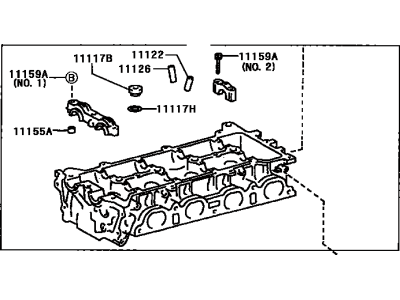

My Garage
My Account
Cart
Genuine Toyota MR2 Cylinder Head
Head- Select Vehicle by Model
- Select Vehicle by VIN
Select Vehicle by Model
orMake
Model
Year
Select Vehicle by VIN
For the most accurate results, select vehicle by your VIN (Vehicle Identification Number).
8 Cylinder Heads found
Toyota MR2 Cylinder Head Sub-Assembly
Part Number: 11101-74160$614.98 MSRP: $780.93You Save: $165.95 (22%)Ships in 1-3 Business DaysToyota MR2 Cylinder Head Sub-Assembly
Part Number: 11101-88386$734.13 MSRP: $941.54You Save: $207.41 (23%)Ships in 1-3 Business DaysToyota MR2 Cylinder Head Sub-Assembly
Part Number: 11101-74110$940.85 MSRP: $1194.73You Save: $253.88 (22%)Ships in 1-3 Business Days
Toyota MR2 Cylinder Head
If you are in demand for superior quality and affordable OEM Toyota MR2 Cylinder Head, then shop with us! We own a wide range of the reduced-priced genuine Toyota MR2 Cylinder Head. You can purchase in confidence as all parts come with a manufacturer's warranty. Any issues with our products? No need to worry as we have a hassle-free return policy to guide you every step of the way.
Toyota MR2 Cylinder Head Parts Questions & Experts Answers
- Q: What steps should be taken for thorough cleaning and inspection of the cylinder head and valve train components during an engine overhaul on Toyota MR2?A:Thorough cleaning of the cylinder head and related valve train components, followed by a detailed inspection, will enable you to decide how much valve service work must be done during the engine overhaul. Clean the combustion chambers with a wire brush to remove all carbon residue, and scrape away old gasket material and sealing compound from mating surfaces, being careful not to gouge the cylinder head. Remove scale build-up from coolant passages, use a stiff wire brush to clean oil holes, and run an appropriate size tap into threaded holes to eliminate corrosion and thread sealant. Clean the threads of the exhaust and intake manifold studs, then clean the cylinder head with a soft brush and solvent, ensuring thorough drying, possibly using compressed air. Clean valve springs, shields, keepers, and retainers with solvent, taking care to clean one valve set at a time to avoid mixing parts. Scrape heavy deposits from the valves and use a motorized wire brush for the valve heads and stems, ensuring not to mix up the valves. Inspect the head surface, intake and exhaust ports, and combustion chamber for cracks, replacing the cylinder head if any are found. Check the cylinder head and manifold mating surfaces for warpage using a straightedge and feeler gauge, and examine valve seats for pitting, cracking, or burning, which would require valve reconditioning. Since checking valve guide clearance requires specialized tools, it is advisable to take the head to a machine shop for this. Inspect each valve face for wear, deformation, and cracks, and measure the margin width, replacing any valve with a narrower margin than specified. Inspect valve springs for wear and pitting, measure their free length, and check for squareness; any distorted or sagged springs should be replaced. Any damaged or excessively worn parts must be replaced, and if the inspection indicates that the valve components are in poor condition, reassemble the valves in the cylinder head for further servicing recommendations. If no excessively worn parts are found and the valve faces and seats are in good condition, the valve train components can be reinstalled without major servicing.





